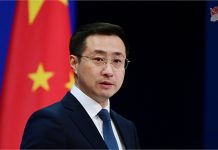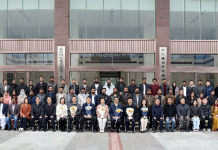Smooth and comfortable—that’s Indonesian President Joko Widodo’s description of his train-taking experience on a super-sleek, silver-bodied high-speed train decorated with a flash of red, after arriv-ing at Padalarang Station in West Java Province, Indonesia, on September 13.
The train, which had departed from Halim Station in Jakarta, ran at full speed on the 142-km Jakarta-Bandung High-Speed Railway—which connects Indonesia’s capital and the country’s fourth largest city Bandung, with a design speed of 350 km per hour. Thanks to these high-speed trains, travel time be-tween the two cities will be cut from more than three hours to around 40 minutes.
It is the first overseas high-speed railway project to fully use Chinese railway systems, technology and industrial components, and will be the first high-speed railway in Indonesia and Southeast Asia at large.
The railway, which Widodo said would officially start commercial operation in early October, stands as a flagship project and a shining example of the infrastructure connectivity achieved through the China-proposed Belt and Road Initiative (BRI).
In September 2013, during a speech at Nazarbayev University in Kazakhstan, Chinese President
Xi Jinping took the audience back in time 2,100 years when Zhang Qian, a diplomat of the Han Dynasty (206 B.C.-A.D. 220), was dispatched to Central Asia with a mission of peace and friendship and opened a Silk Road that then took Chinese silk, tea and porcelain to other parts of the world and brought back spices, glassware, furs, fruits and precious stones.
“Today, as I stand here and look back at that era in history, I can almost hear the camel bells echoing in the mountains and see the wisps of smoke rising from the desert,” Xi said.
But it was never a speech about nostalgia. Instead, Xi drew inspiration from the successful trade routes of the ancient Silk Road and proposed the idea of building a Silk Road Economic Belt. This, along with the 21st-Century Maritime Silk Road proposed by him in Indonesia later that same year, went on to form the BRI which aims to boost connectivity along and beyond the ancient Silk Road routes.
In the past decade, the initiative has achieved fruitful outcomes in promoting policy coordination, facil-ities connectivity, unimpeded trade, financial integration and people-to-people bonds between China and its partners.
Greater connectivity
Traditional camel caravans along the Silk Road now have been replaced by modern freight trains.
Thirty-five-year-old Dong Yan is one of the drivers in Urumqi, capital of Xinjiang Uygur Autonomous Region in northwest China. When he landed the job in 2013, he and his colleagues were responsible for driving westbound international freight trains from Urumqi to the region’s inland port of Alataw Pass.
Following the proposal of the BRI that same year, the number of trains from China to Central Asia, Eu-rope and other countries has greatly increased. “I have seen higher speeds, more quantity and more abundance—in terms of goods,” Dong said. He has, in the past decade, driven more than 850 freight trains and traveled some 250,000 km from Urumqi to Alataw Pass and Khorgas, another border port in Xinjiang, equivalent to more than six times around the Earth.
Since 2013, some 77,000 China-Europe freight train trips have been made, providing services for 217 cities in 25 European countries, Cong Liang, deputy head of the National Development and Reform Commission (NDRC), China’s national economic planner, said on September 15 at the China-Europe Railway Express Cooperation Forum in Lianyungang, Jiangsu Province, adding that those freight trains have transported 7.31 million twenty-foot equivalent unit (TEU) containers of goods worth a total of $340 billion. TEU is an inexact unit of cargo capacity, often used for container ships and container ports.
“With the BRI, China promotes infrastructure development and connectivity across continents, offer-ing a chance for countries to enhance their trade networks and expand their economic potential,” Seun Sam, a policy analyst at the Royal Academy of Cambodia, told Xinhua News Agency.
The import and export of goods between China and BRI partners in the 10-year period increased by an average of 8.6 percent annually, Zheng Shanjie, head of the NDRC, said in August, adding that their cumulative two-way investment has exceeded $270 billion.
The logic behind the initiative is to turn many of the seemly marginal areas around the world into piv-ots through connectivity, to form a global network where every participating country can enjoy shared benefits, Chen Wenling, chief economist at the China Center for International Economic Exchanges, said.
In other directions, the 1,035-km China-Laos Railway, which links the Lao capital of Vientiane with Kunming, capital of Yunnan Province in southwest China, has generated enormous advantages since its launch in December 2021.
It has delivered 19 million passengers and 24 million tons of freight, with its cross-border cargo transport covering over 10 countries and regions. The railway has already dovetailed the BRI with Laos’ strategy to convert itself from a landlocked country to a land-linked hub on the Indochina Peninsula.
Indonesia President Joko Widodo aboard a train running on the Jakata-Bandung High-Speed Railway in Indonesia on September 13 (XINHUA)
Combined construction
As of June this year, China had signed more than 200 Belt and Road cooperation documents with 152 countries and 32 international organizations, covering 83 percent of the countries with which China has established diplomatic relations.
According to a 2019 World Bank report, with moderate assumptions on BRI investment, the simulation results indicate a 1.3-percent in global GDP by 2030, accompanied by a 5-percent boost to global trade.
GDP is the total market value of goods and services produced by a country’s economy during a specific time frame and measures the health of national and global economies. GDP growth signals a positive economic outlook, whereas a decline may forebode a recession.
With wind turbines spinning, highways stretching forward and seaports operating around the clock, BRI projects from the Mediterranean to the Baltic have displayed vim and vigor.
Take the example of Greece’s Piraeus Port. After China COSCO Shipping took over management of the decaying chief sea port of Athens, which in 2010 found itself on the verge of bankruptcy, it has been transformed into a hub of maritime transportation between Asia, Europe and Africa.
Container throughput has grown from 880,000 TEUs in 2010 to over 5 million TEUs today, making it a leading port in the Mediterranean. This has, in turn, directly created over 3,000 job opportunities for the local community and indirectly generated more than 10,000 additional jobs, Xiao Junzheng, Chi-nese Ambassador to Greece, told English-language Chinese newspaper Global Times.
The New International Land-Sea Trade Corridor is another flagship project under the initiative. Launched in 2017, it’s a trade and logistics passage that was jointly built by provincial-level regions in west China and members of the Association of Southeast Asian Nations (ASEAN).
In the first half of this year, the number of cross-border rail-sea intermodal trains reached 4,510, up 9 percent year on year. International railroad trains totaled 4,091, an increase of 18.51 percent, according to Xinhua.
The corridor also allows for Southeast Asian specialties such as Lao sticky rice, Thai durian, Vietnamese balsa fish and Cambodian bananas to enter the Chinese market more quickly.
The BRI is widely popular among developing countries, Julio Rios, a Spanish expert on China, told Xinhua. The initiative has become a public good, contributing not only to China’s development but also to the modernization of the world at large, he added.
A recent report by the Chinese Embassy in Bangladesh shows that the initiative will help the South Asian country’s real GDP grow by at least 2.1 percent, generate an additional 2.5 percent to 5.1 percent of employment and decrease extreme poverty by 1.3 percent.
“As we have seen over the past few years, the BRI has changed the landscape of Bangladesh,” Bangla-deshi Minister of Commerce Tipu Munshi said in his message to the report, adding that Chinese in-vestment in the country’s power sector has enabled Bangladesh to achieve 100 percent electricity coverage.
According to the report, depending on the specific scenarios considered, the BRI projects are antici-pated to create an additional 1.8 to 3.6 million employment opportunities in the country.
M.A. Mannan, Bangladeshi Minister of Planning, with his ministry overseeing the financial policies of the Bangladeshi Government, said in his message that his country, as a member of the BRI global co-operation alliance of China, has already started benefiting from the initiative, including China’s financial investment and contractual construction obligations.
Common expansion
The 2019 World Bank report further estimated that the full implementation of BRI transportation pro-jects could increase global income by 0.7 percent to 2.9 percent by 2030, lifting 7.6 million people out of extreme poverty and 32 million out of moderate poverty worldwide.
Take the example of Angola on the African continent. The country has long suffered inadequate ac-cess to safe drinking water, increasing the risk of spreading infectious diseases like cholera and dysen-tery. In June 2022, the China Railway 20th Bureau Group Angola International Co. finished the con-struction of a water supply project in the northwestern province of Cabinda.
“It used to be a long walk to the well to fetch water, and this was a grueling task,” a local resident called Adriano told Xinhua, adding that more than 400 households in his community had been impact-ed by the water scarcity for decades.
“Now, the water pipe is connected to our doorstep, and we have clean and hygienic tap water at our disposal every day,” he added.
The project comprises 74 centralized water supply points, covering 24,000 households or 92 percent of the province’s residential communities, Zhu Qihui, head of the company, said.
“Angola is not short of water, but the water resources are not used efficiently. Thanks to the Chinese companies, the situation is improving,” Angolan Minister of Economy and Planning Mário Augusto Cae-tano João said, adding that Chinese companies have brought in technology and knowhow to improve local livelihoods and spur sustainable development.
In addition to promoting infrastructure construction, the BRI should give equal importance to develop-ing industries with comparative advantages in participating countries, and then transform these into the countries’ competitive advantages, Justin Yifu Lin, a former World Bank chief economist and a pro-fessor at Peking University, said. Advantageous industries, through their development, can generate more job opportunities and benefit locals, he added.
The initiative promoted intraregional and interregional connectivity and cooperation among all partici-pating countries in all areas, such as infrastructure, connectivity, economy, investment, finance and cultural exchange, Kin Phea, Director General of the International Relations Institute of Cambodia, a think-tank under the Royal Academy of Cambodia, said.
“It is a new global force of peace, security, stability, development, prosperity and harmony,” Phea added. –The Daily Mail-Beijing Review news exchange item





